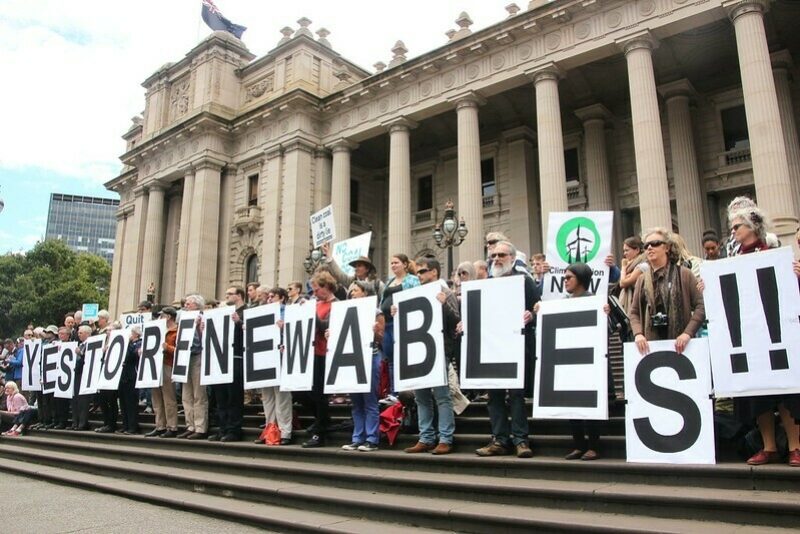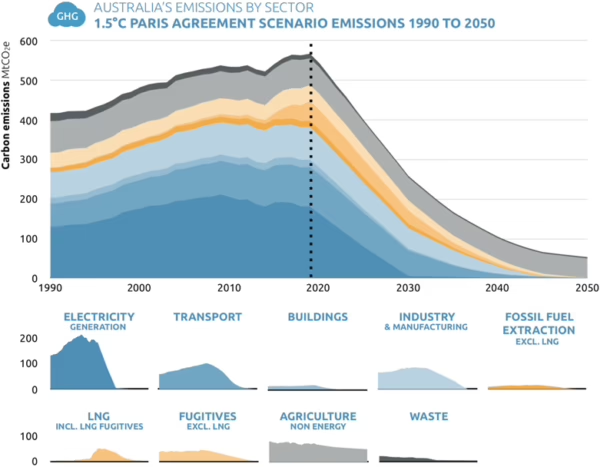Australia can move to net-zero emissions by 2050, and would benefit from it - new Climate Action Tracker report
Share

In the ‘Scaling up Climate: Australia’ report, released today, the CAT has found that accelerating a transition to a zero-carbon, renewables-based electricity supply by the 2030’s will bring large domestic employment opportunities. It shows an economically and technically feasible pathway that results in more than halving emissions by 2030 and achieves net zero greenhouse gas emissions by 2050 through action across all sectors of the economy.
The report is published as a bill is introduced to the Australian Parliament proposing a bipartisan approach to climate change, setting up a clear framework toward achieving a net-zero emissions by 2050 goal.
“This report shows how Australia can get on a pathway to net zero emissions in line with the Paris Agreement goal of limiting warming to 1.5C, increasing employment and ratcheting up its 2030 target from the currently inadequate 26-28% to a 66% emissions reduction,” said Bill Hare, CEO and Senior Scientist of Climate Analytics.
“We show how this is feasible. But it needs real climate policy across all sectors of the economy. An important first step to achieving this is a planned and managed phase-out of coal from power generation by 2030.”
“We’ve found there is enormous potential – and indeed many benefits – for Australia to shift to a world-leading, net zero emissions regime, creating opportunity and future-proofing it against the inevitable shock of fossil fuel divestments,” said Dr Ursula Fuentes Hutfilter, Senior Policy Adviser at Climate Analytics Australia, Perth.
“Unlike other reports, our modelled scenarios do not rely on extensive carbon storage through carbon sequestration in the land sector. We provide a more balanced approach that protects biodiversity and water resources to compensate for emissions from hard-to-abate sectors such as agriculture, thus,” she said.
“We also see no role for any additional gas in the electricity sector, not even as a transition fuel: we simply won’t need it.”
The report
The in-depth analysis focuses on Australia’s potential to increase mitigation efforts in the electricity supply, transport, industry, and buildings sectors, while providing an integrated energy system approach and a pathway for greenhouse gas emissions reductions across all sectors consistent with the Paris Agreement 1.5degC limit.
It first reviews the current policy framework then undertakes a scenario analysis, using Paris Agreement benchmarks, “best in class” international frontrunners, and national scenarios, taking into account the specific characteristics of Australia’s energy intensive industry and LNG export sector and the current focus on extraction and export of fossil fuels, and the key role of the power sector to decarbonise these sectors by, at latest, 2050.
The report relies on two models: the “Prospects” model developed by the CAT for its “Scaling Up Climate Action” series, and energy system model developed for Australia “AuseMOSYS” developed by Climate Analytics.

Key findings
Accelerating the transition towards a renewables-based electricity supply by the 2030’s will bring large additional employment opportunities to Australia which, if combined with policies to incentivise more local manufacturing of wind turbines, solar panels and batteries, would reach 76,000 by 2030.
- Renewable energy in electricity supply can reach 97% by 2030, 99% by 2035 and 100% by 2040.
Gas is not needed as a transition fuel, contrary to government claims
- The share of gas for power generation would decrease from today’s level of 20% to around 3% by 2030, 1% by 2035 and gone by 2040.
- Gas needs to be phased out globally by the 2040’s, with the LNG industry reducing emissions well before then.
There is no need for any increase in gas for power generation due to the increasing cost-efficacy of battery storage, pumped hydro, demand-side management and the integration of hydrogen and EV storage systems into the grid.
Coal-fired power can be phased out by 2030 in a planned and regulated process to enable a just transition – using renewables and advanced storage – without gas.
Electrification of transport and industry requires an increase in electricity generation by 2030 of 32% above 2019 levels, and a further 23% increase by 2040 above 2030 levels.
- This enables electrification of end-use sectors, including EV’s in transport and green hydrogen for domestic use.
Accelerated climate action can halve Australia’s GHG emissions from fossil fuels, transport, industry and agriculture and other sectors (not including land use, land-use change and forestry sectors – LULUCF) by 2030, and reduce these to 90% below 2005 levels by 2050.
To fully reach a Paris Agreement compatible pathway strong action to halt deforestation by 2030 and maintaining forests for carbon storage through to 2050 will be needed.
- By 2030 total GHG reductions of 66% by 2030 can be achieved.
- Net-zero GHG emissions can be achieved by 2050
Land sector carbon storage is needed to outweigh remaining GHG emissions from hard-to-abate sectors, especially agriculture, and requires a balanced approach that protects biodiversity, water resources and avoids relying on carbon storage in the land sector beyond sustainable limits.
The Australian car and bus fleet can be close to 40% (38%) electric on the road by 2030 and, combined with the decarbonisation of the power sector, can be fully decarbonised by the middle of the century.
There is huge potential in decarbonising the buildings sector, so far untouched by any climate policies, promoting energy efficiency, and bringing other benefits, such as health.
Reductions of non-energy emissions in the agricultural sector, particularly of methane and nitrous oxide, are expected to be much slower than in all other sectors and will rely on enhanced agricultural management (e.g. manure management, improved livestock feeding practices, and more efficient fertiliser use) and other measures to achieve a 35% reduction of methane and nitrous oxide emissions by 2050.











